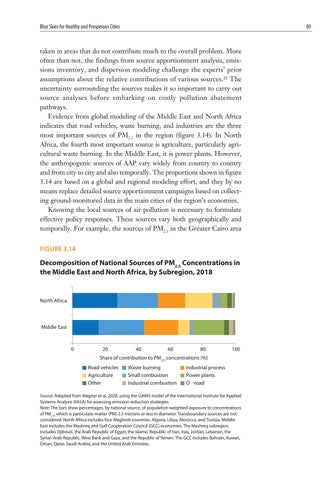Blue Skies for Healthy and Prosperous Cities
89
taken in areas that do not contribute much to the overall problem. More often than not, the findings from source apportionment analysis, emissions inventory, and dispersion modeling challenge the experts’ prior assumptions about the relative contributions of various sources.19 The uncertainty surrounding the sources makes it so important to carry out source analyses before embarking on costly pollution abatement pathways. Evidence from global modeling of the Middle East and North Africa indicates that road vehicles, waste burning, and industries are the three most important sources of PM2.5 in the region (figure 3.14). In North Africa, the fourth most important source is agriculture, particularly agricultural waste burning. In the Middle East, it is power plants. However, the anthropogenic sources of AAP vary widely from country to country and from city to city and also temporally. The proportions shown in figure 3.14 are based on a global and regional modeling effort, and they by no means replace detailed source apportionment campaigns based on collecting ground-monitored data in the main cities of the region’s economies. Knowing the local sources of air pollution is necessary to formulate effective policy responses. These sources vary both geographically and temporally. For example, the sources of PM2.5 in the Greater Cairo area FIGURE 3.14
Decomposition of National Sources of PM2.5 Concentrations in the Middle East and North Africa, by Subregion, 2018
North Africa
Middle East
0
20
40
60
80
100
Share of contribution to PM2.5 concentrations (%) Road vehicles Agriculture Other
Waste burning Small combustion Industrial combustion
Industrial process Power plants O -road
Source: Adapted from Wagner et al. 2020, using the GAINS model of the International Institute for Applied Systems Analysis (IIASA) for assessing emission reduction strategies. Note: The bars show percentages, by national source, of population-weighted exposure to concentrations of PM2.5, which is particulate matter (PM) 2.5 microns or less in diameter. Transboundary sources are not considered. North Africa includes four Maghreb countries: Algeria, Libya, Morocco, and Tunisia. Middle East includes the Mashreq and Gulf Cooperation Council (GCC) economies. The Mashreq subregion includes Djibouti, the Arab Republic of Egypt, the Islamic Republic of Iran, Iraq, Jordan, Lebanon, the Syrian Arab Republic, West Bank and Gaza, and the Republic of Yemen. The GCC includes Bahrain, Kuwait, Oman, Qatar, Saudi Arabia, and the United Arab Emirates.






